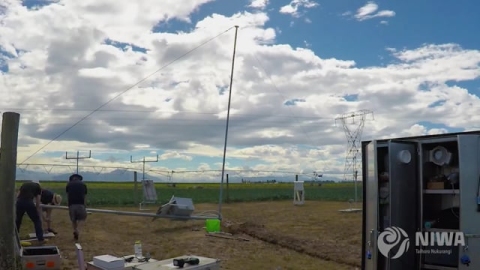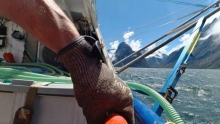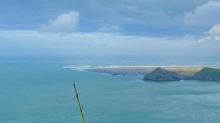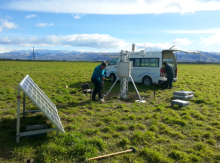April 2021: Latest CarbonWatch results presented at EGU
NIWA atmospheric researcher Beata Bukosa presented the newest carbon budget estimates from CarbonWatch NZ at the 2021 European Geoscience Union General Assembly. Results point to persistently stronger carbon uptake between 2014 and 2020 relative to our National Inventory. Findings suggest that the additional CO2 sink originates from mature, indigenous forests in the Fiordland region. This suggests that such environments might have the potential to absorb more carbon than previously thought, which could potentially impact New Zealand's land management. Watch this space for more detail to come.
March 2021: Winchmore station installed

A long-term greenhouse gas monitoring station has been installed at Winchmore in Canterbury. The site is mid-way between the mountains and the sea and surrounded by different types of carbon source and sink. The station will measure carbon dioxide and methane – with methane of particular interest here due to the surrounding farmland. The site benefits from a long-running weather station, providing an excellent dataset on precise local conditions and wind directions.
December 2020: RV Kaharoa voyage to study carbon uptake by Fiordland forests

A CarbonWatch NZ pilot study in 2017 suggested that Fiordland’s native forests absorb more carbon dioxide than expected. To look into this further, some of the CarbonWatch team carried out simultaneous measurements of carbon dioxide in the air from land and sea (on NIWA’s research vessel RV Kaharoa) over several days, to assess carbon uptake by the forest as air moved across. Sampling weather was ideal, although this meant gale force winds and 8m waves for those on the ship! The researchers also took water samples to assess carbon exchange in the Fiords and nearby coastal waters. Watch this space for results.
October 2020: Manakau Heads station up and running

This new site will shed new light on greenhouse gas emissions and uptake in Northland and the Waikato. Two more Auckland sites are in development – together, these will also support CarbonWatch NZ’s urban greenhouse gas work in Auckland led by GNS Science.
April 2020: Gas lab reopens and future proofing at Baring Head site (level 3 restrictions)
Under level 3 restrictions to combat COVID-19, NIWA is re-opening its Greta Point gas lab to allow analysis of greenhouse gases in air samples to resume.
Our monitoring station at Baring Head has been running continuously and, with the team now able to return to the site, we are putting systems in place to enable more flasks to be automatically filled with air samples over a longer time. This will help to future proof the work if there is another lockdown and staff become unable to visit again.
March 2020: CarbonWatch NZ continues during COVID-19 (level 4 restrictions)

NIWA’s work maintaining national monitoring networks for atmospheric chemistry – including the greenhouse gas measurements on which CarbonWatch NZ depends – continued under the level 4 lockdown to combat COVID-19. However changes were made to processes to enable much of the work to be done remotely. Some tasks, such as installation of new monitoring sites, had to be put on hold temporarily.
Immediately before the lockdown, quick-thinking CarbonWatch NZ researcher Gordon Brailsford (responsible for NIWA’s Baring Head monitoring station) set up a lab in his garage in Lower Hutt, enabling him to monitor local levels of carbon dioxide (CO2 ), carbon monoxide (CO) and methane (CH4). While Gordon expects to see a decrease in observed CO2 levels at Baring Head, it will take some time for this to filter through. However he is hoping to see changes in his urban environment more readily, with carbon monoxide from cars and industrial sources already much lower than normal.
November 2019: Atmospheric Scientist vacancy - join the CarbonWatch NZ team!
We're on the hunt for someone to support the long running observations at our atmospheric observing site, Baring Head near Wellington, and the establishment of eight new greenhouse gas observing stations throughout New Zealand as part of CarbonWatchNZ.
October 2019: CarbonWatch NZ seeking PhD student for greenhouse gas measurements and monitoring
CarbonWatch NZ has an exciting three-year opportunity for someone to assist with one or more newly established in situ greenhouse gas observing stations, analysing greenhouse gas data from established stations, and interpreting the measurements using model simulations.
August 2019: First flux tower set up in Central Otago

The first new flux tower has been installed in Central Otago. Adjacent to NIWA's optics observatory laboratory at Lauder, it's the first time a flux tower has been sited alongside a long-term greenhouse gas observation site with its own 10m mast and gas sampling capability. The new tower measures the exhange of CO2 between the atmosphere and the pasture immediately upwind - this will reveal important insights about the balance between photosynthesis during the day and respiration from the soil and plants at night.
June 2019: Air sampling in Fiordland for carbon cycle studies
Regular air sampling in Fiordland has recently begun with the goal to study carbon fluxes in one of New Zealand’s most pristine, native forests. New equipment was designed, built and tested in Wellington before it was successfully deployed at two field sites in Fiordland: At “McCracken’s Rest” near the South-Western tip of the South Island’s coast, and at fringe of Lake Monowai, some 50 km inland from the Southern coast. Sampling will continue at these two sites and we will also investigate further potential sites for the future.
May 2019: First CarbonWatch NZ meeting
NIWA hosted the first meeting for investigators and stakeholders of the MBIE-Endeavour funded CarbonWatch NZ project. Four sessions addressed the different research areas of the project: national scale estimates, grassland carbon exchange, forest carbon exchange and Auckland urban CO2 emissions. In each session, stakeholders from central or local government or forest trusts presented their insights and interest in the research followed by the investigators from NIWA, GNS Science, Landcare Research, and University of Waikato. Discussions galvanised the research strategies to identify the best measurements and modelling approaches for the most relevant research questions.
April 2019: CarbonWatch NZ lead presents project at EGU General Assembly
Sara Mikaloff Fletcher was invited to talk about CarbonWatch NZ at the European Geophysical Union (EGU) General Assembly earlier this year. This special union-wide session was held as the World Meteorological Organization's Global Atmosphere Watch (GAW) programme celebrated its 30th anniversary. The programme included one invited talk for each category of atmospheric measurements that GAW supports, highlighting how the atmospheric greenhouse gas measurements programme has evolved from pure research to providing benefits to decision makers.
Read more at https://public.wmo.int/en/media/news/global-atmosphere-watch-programme-turns-30

